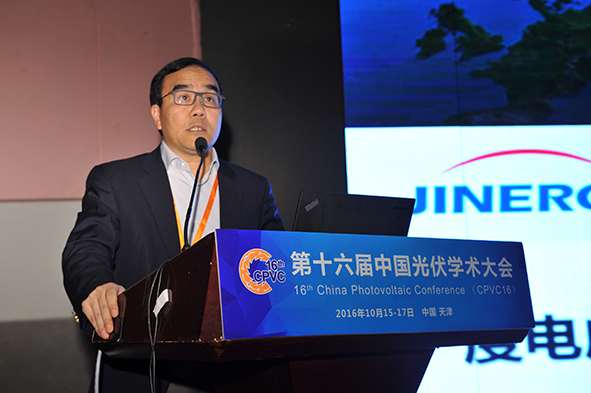Product and Service
JINERGY: Breakthroughs in HJT Technology Contribute to Grid Parity in 2017
On 15 October, the 16th China Photovoltaic Conference (CPVC) co-sponsored by China Photovoltaic Society (CPVS) and Nankai University was held at Tianjin. This session focused on innovative development of advanced PV technology, aiming at discussing and exchanging technological innovations and academic results in scientific research innovation, so as to expand international cooperation and facilitate the sustainable & healthy development of domestic PV industry.
For more than 30 years, CPVC has become an annual conference of PV industry with the greatest influence and authoritativeness in China. This year, CPVC has specially invited ZHAO Ying, Director of CPVS, YANG Deren, Deputy Director of CPVS, WANG Shijiang, Deputy Secretary General of China Photovoltaic Industry Association (CPIA), WANG Sicheng, Deputy Secretary General of CPVS, XU Honghua and ZHAO Yuwen, Deputy Directors-General of China Renewable Energy Society (CRES), SHEN Hui, Head of the Institute for Solar Energy System of Zhongshan University, FENG Zhiqiang, VP Technology of Changzhou Trina Solar Energy Co., Ltd., YANG Liyou, General Manager of Jinneng Clean Energy Technology Ltd., and many other industry experts, scholars, elite representatives from industry institutes and enterprises to attend the conference and share their unique thoughts about “new materials, new concepts and new structures of solar cells”, “process development of solar cells”, “PERC, PERT and other solar cell technologies”, “high-efficiency heterojunction (HJT), IBC, TOPcon and similar solar cell technologies”, “materials, high-efficiency technologies and reliability of PV modules & systems”.

YANG Liyou, General Manager of Jinneng Clean Energy Technology Ltd. (JINERGY), attended the conference and delivered a keynote speech on LCOE Drives Continuous Industrialization Technology Progress. YANG Liyou claimed that China has recently become a leader in terms of the scale, technological optimization and improvement of PV industry under the joint efforts of all sectors, including industry, academia and research, and the strong driven force of domestic and foreign markets in particular. Besides, China has achieved a remarkable drop in the LOCE cost and got closer to the dream of PV Power Generation at Grid Parity.
According to him, IPCE of PV module will greatly affect to the cost of integrated system and LCOE owing to an increased PV projects cost covering engineering issue, land use, support establishment, cable pulling and modules installation. Therefore, the industrialized technologies development of crystalline silicon solar cells mainly lies in an improvement of cells conversion efficiency.
The highest average conversion efficiency of conventional polycrystalline cells has reached 18.9%. Among 60 standard pieces of modules, the average efficiency of 70% belongs to 270W and that of the remaining 30% belongs to 275W, completely surpassing the standard set by Top Runner Program and creating strong competitiveness in terms of cost effectiveness. However, a certain gap still exists between the LCOE of PV electricity generation and the on-grid price of coal-fired power generation.
The mass production technology of PERC cells gradually matures after 3-4 years’ efforts, with effective control on excessive LID and comprehensive release of 5GW capacity. Optimized process for producing aluminum oxide films and other key components contribute to an increase in the average conversion efficiency of monocrystalline PERC cells to above 21% through mass production, the highest record at present, as well as an improvement in the power of modules to 295W and a 5% rise in cost effectiveness per watt compared with conventional monocrystalline modules. It is believed that the average conversion efficiency of PERC cells will reach 21.5% and its cost will parallel that of conventional ones through further optimization. However, the PERC cell advantages in cost effectiveness reveals only when them are applied in systems with relatively high land cost and labor cost, such as distributed system.
Besides, there are great prospects in the industrialization of HJT cells for its various strengths, such as relatively simple production process, double-sided electricity generation, excellent low light performance, great temperature coefficients, low rate of LID, and a power output per watt as high as 120%. Nowadays, many domestic enterprises have announced their plans for industrialization of HJT cells. A relatively large amount of HJT cell products will be available by 2017.
According to YANG Liyou, preliminary breakthroughs and advantageous cost-effectiveness of HJT technology will be achieved in 2017; grid parity will be realized around 2020. By then, PV electricity generation modules with high-efficiency and high-performance will play a greater role in optimizing the cost structure of power generation.
It is said that JINERGY will devote itself to the development & production of high-efficiency polycrystalline PV modules, PERC high-efficiency monocrystalline PV modules and N-type HJT super high-efficiency monocrystalline PV modules, in accordance to the strategy of iterative evolution. JINERGY’s overall capacity of is estimated to exceed 3GW by the end of 2018.

